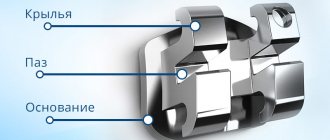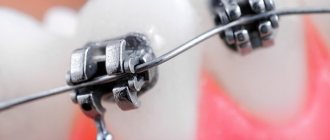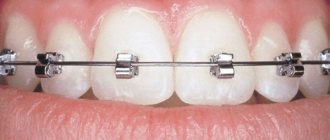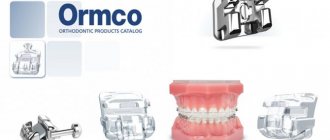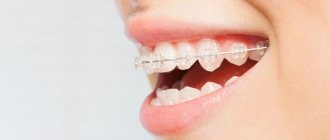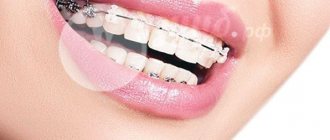Braces are one of the most popular and effective methods of bite correction today. Modern orthodontics offers two main types - ligature and self-ligating braces. This article will discuss the non-ligature braces system.
In this article
- How do braces work?
- Self-ligating and ligature braces - what are these systems and what are their differences?
- Pros of ligature-free braces
- Metal and ceramic self-ligating braces - which are better?
- Sapphire and plastic braces - what to choose?
- How are self-ligating braces installed?
Advantages and disadvantages of self-ligating braces
| Advantages | Flaws |
|
|
Hygienic care of braces
In order for the Clarity bracket system to serve the entire period of treatment without problems and not lose its aesthetic appearance, it is necessary to follow the orthodontist’s recommendations for careful care of braces. Therefore it is necessary:
- after any meal, brush your teeth thoroughly;
- reduce consumption of food containing dyes;
- It is recommended to quit smoking during treatment;
- monitor the consumption of hard and solid foods that can damage the system.
Types of self-ligating bracket systems
By location
Self-ligating braces can be either vestibular (located on the outside of the teeth) or lingual (located on the side of the tongue). The first option is more affordable, the second is the most aesthetically pleasing of all possible, since the systems are completely invisible on the teeth. They are even called “invisible” braces. Naturally, they have a high price.
Based on materials
Ligature-free systems can be made of various materials. The most common is metal (alloys of inexpensive metals or containing gold, titanium). More aesthetic materials are ceramics and sapphires. When choosing a self-ligating design, each bracket plate is supplemented with a metal groove and/or lock, which will ensure retention of the metal arch. This option is less aesthetic, but more effective, since the arc force on a smooth ceramic surface is noticeably reduced.
By type of design
Self-ligating bracket systems are considered to be the standard of orthodontic treatment. However, in practice, everything is not so smooth: they are suitable only for some patients, however, like any other construction for correcting the bite.
There are two types of ligation - active (the arch is tightly clamped inside the staple) and passive (the arch slides freely). Each of them is used to solve specific problems - tooth rotation, movement back and forth or sideways. While ligature systems allow you to easily adjust the type of ligation, in self-ligating constructs it is initially one: active or passive. With such an approach, at a certain stage the treatment may reach a dead end - which is why the indications for the use of these braces are strictly defined.
Today there are brace systems that allow you to change the type of ligation - from non-ligature to ligature, from passive to active, thereby solving even the most complex problems.
Description of non-ligature systems
The main feature of self-ligating orthodontic systems is the absence of ligatures. The arch is not fixed on the bracket plate, but slides smoothly in the grooves of the locks. This provides sufficient force, but at the same time makes the correction process softer and more natural. Such braces do not require frequent adjustments like ligature devices, so the number of scheduled visits to the clinic is slightly reduced. The benefits also include easier hygiene care.
Metal and ceramic non-ligature bracket systems are especially popular.
Popular brands
There are not many self-ligating braces on the market, but the patient has a very good choice: these are lingual systems, vestibular metal or aesthetic ceramic, sapphire systems. They are produced by various companies. Let's look at the most popular brands, ranked by cost (in increasing order):
- Prodigy (USA): inexpensive self-ligating braces made of metal. Strong, durable and efficient, easy to install and remove,
- Lotus (USA): they are almost a complete analogue of the Damon system, but are more affordable. Made of metal, have a low profile, which increases comfort,
- Quick (Germany): metal systems without nickel content, which minimizes the risk of allergic reactions. They have a low profile, which makes them quite comfortable and reduces the adaptation time,
- Empower (USA): braces that are made of metal or ceramic, complemented by a metal clip. Metal systems have a low profile, ceramic systems have high aesthetics and efficiency due to the addition of a metal groove,
- Experience (Germany): a line of some of the most effective self-ligating systems, which are available in three modifications - metal (classic and mini) and ceramic. Equipped with a heavy-duty innovative kink-resistant latch,
- Damon (USA): a line of braces that are made of metal, sapphire or ceramic. Equipped with a cover of a special patented design, which allows you to easily open and close the lock without chipping or breaking, even with frequent replacement of the arches,
- QuicKlear (Germany): ceramic braces that are equipped with both a ceramic and a metal lock. Aesthetic and quite effective - treatment periods with systems are from 1.5 years,
- In-Ovation (USA): a series of braces made from metal or ceramics. Metal systems can also be vestibular or lingual. Some of the most expensive designs, which are highly effective and allow you to correct your bite as quickly as possible,
- 2D (Germany): lingual braces that have a template shape. Due to this, their price is quite low compared to other similar systems. They have a low profile and a polished surface, so it won’t take much time to get used to them,
- SmartClip (USA): metal braces that are made of nickel and titanium, therefore minimizing the risk of breaking the locking fastener,
- Clarity SL (USA): made of ceramic, complemented by a metal groove and lock. Due to this, it is possible to maintain aesthetics and increase the efficiency of the system,
- Insignia (USA): vestibular metal braces that are developed individually for each patient directly in a company located in the USA. Due to the accuracy and predictable results, they are quite expensive,
Which ceramic braces should you choose?
Evgenia Belousova notes that if we talk about treatment time and price range, then it is quite difficult to compare ceramic braces, because they, like metal ones, are presented on the market by different companies and, most importantly, systems. “Which one to choose from the whole variety is decided individually by the doctor and the patient, they discuss all the pros and cons and choose what is right for a particular person, what he is ready to turn a blind eye to and what advantages to choose for himself.” Evgenia Aleksandrovna explains that a lot depends on what system the specialist is used to working with, since everyone has their own approach: some use different systems, others prefer to concentrate on one, which becomes their “trick”.
Ceramic braces, like metal ones, are divided into ligature and non-ligature, or self-ligating. The first are connected to the arch, that is, to the main system that moves the teeth, using a rubber ring or metal wire.
Evgenia Belousova: “The disadvantage of this technique is that there is another additional means of connection, and it is rubber and more porous, accordingly, more plaque collects on it. Also, this rubber ring creates additional friction in the system, and the teeth take longer to move.”
Ceramic self-ligating braces are a snap-on design that closes without requiring any attachments to function properly, providing better hygiene and reducing discomfort from adjustment and wear.
Important! The most significant disadvantage of sapphire braces is the fact that they are only ligature!
Self-ligating braces: patient reviews
“The patient should always remember that the doctor is treating, not braces! And even the most expensive braces may not be effective in the hands of an orthodontist who doesn’t know how to do anything. This is exactly what happened to me. Initially, I installed regular metal braces. A YEAR passed, but nothing changed. Or rather, the teeth moved apart, of course, but the result was not what was needed. I went to another doctor, took off the braces, and put them on again... now without ligature. And in six months we corrected all the mistakes of the past. So there is something to compare with - heaven and earth! Self-ligating ones are just a fairy tale; they don’t make your teeth hurt so much! Although, of course, it’s different for everyone, maybe it happened like this for me because I’ve already been treated before.”
Marina Kochneeva, Ekaterinburg
“My doctor was categorically against self-ligating ones, supposedly ligating ones are better. I chose another doctor because going to the orthodontist all the time is too difficult. I didn’t regret it at all - there was practically no pain, it was comfortable, convenient. I've already counted about ten pluses. There are also a couple of disadvantages, of course, and one of them is the price. But the systems are working, I’ve been wearing them for 7 months and still have another month left according to forecasts. At first I rarely visited the doctor, but in the middle they changed the arches almost every month.”
Mikaellina, from correspondence from forums
“I regret my choice a little - I installed the usual metal ones, the cheapest ones, but now I pay a couple of thousand every month for changing the rubber bands + the arches also need to be changed periodically, this is even more expensive. I'm afraid I'll overpay at the end of treatment! My colleague doesn’t pay that much for self-ligating ones, it feels like he doesn’t go to the doctor at all...”
Ksenia S., 28 years old, Moscow
How to install Clarity braces
Installation of the Clarity bracket system takes place in several stages. At the initial consultation, the doctor examines the patient and, if necessary, performs a complete sanitation of the oral cavity, followed by professional cleaning of all teeth. This is a mandatory condition, without which further treatment is simply impossible.
Next, the orthodontist orders an x-ray and, based on its results, selects the optimal model of the brace system.
He then takes impressions of the teeth in both jaws and sends them to the dental laboratory.
The final stage is the installation of braces. In this case, the surface of each tooth is polished with a special paste, after which braces are glued and an arch is pulled through special grooves.
Cost of self-ligating braces
Self-ligating braces are quite expensive. This is explained by the fact that manufacturers have to invest heavily in research and testing of systems to achieve their maximum efficiency. Non-ligature braces must work independently, so for such “smart” designs the patient has to pay 2-3 times more than ligature systems.
| Brand name | Cost, rub. |
| Metal braces | |
| SmartClip (USA) | from 100000 |
| Quick (Germany) | from 60000 |
| Damon 3MX, Damon Q (USA) | from 100000 |
| Insignia (USA) | from 90000 |
| Prodigy (USA) | from 40000 |
| Empower Metal (USA) | from 60000 |
| Lotus (USA) | from 50000 |
| In-Ovation R (USA) | from 80000 |
| Experience metal (Germany) | from 50000 |
| lingual Incognito (USA) | from 400000 |
| lingual 2D (Germany) | from 80000 |
| lingual In Ovation L (Germany) | from 100000 |
| lingual Win (Germany) | from 360000 |
| Ceramic braces | |
| Clarity (USA) | from 110000 |
| QuicKlear (Germany) | from 80000 |
| Damon-3 (USA) | from 90000 |
| Empower Clear (USA) | from 80000 |
| In-Ovation C (USA) | from 90000 |
| Experience ceramic (Germany) | from 80000 |
| Sapphire braces | |
| Damon Clear (USA) | from 90000 |
Peculiarities
No locks. The orthodontic arch, which forms the corrective force, is attached without the use of ligatures. Instead, spring clips, latches or latches, and elastic elements are installed.
Sliding arc mount. When using non-ligature braces, the arch can move within the mounts within specified limits.
Compact sizes. Correct and precise distribution of the corrective force makes it possible to reduce the size of the entire structure.
Do you have questions about self-ligating braces?
We will call you back within 30 seconds
+7
Popular questions and answers about self-ligating braces
Is it worth overpaying for self-ligating systems? Are they really more effective?
The technology of correcting the bite and position of teeth through constant but gentle pressure allows treatment to be carried out with the least risk and greater efficiency. However, this does not mean that correcting a bite with self-ligating systems will take less time - depending on the initial situation, the condition of the roots of the teeth, their position, the quality of the bone tissue; treatment, on the contrary, can be longer. In any case, the choice of system for treatment should primarily be up to the orthodontist. Self-ligating systems are more comfortable, do not lead to such frequent inflammation of the mucous membranes, do not cause acute painful sensations, and moreover, they are easier to care for - so the high price is completely justified.
Why are self-ligating braces more expensive?
Ligature-free braces have a more complex design and operating mechanism, which makes them more expensive. In addition, systems often fall into the aesthetic category, that is, they are created from expensive ceramics and sapphires, complemented by metal grooves. This also affects the cost.
Preliminary diagnostics and installation
As in the case of metal braces, before installing ceramic braces you will have to undergo a rather serious preliminary examination, which will allow you to conduct a comprehensive assessment of the condition of the oral cavity and identify hidden defects. After the initial examination, the orthodontist draws up a photo protocol and makes plaster casts, which will later be used to carry out the necessary measurements and calculations. Careful computer diagnostics and lateral projection images make it possible to determine the size of the jaw and find out where there is a deficiency or, on the contrary, excess space. In addition, this test allows the doctor to see “through” the soft tissue and more accurately determine the problem.
If the orthodontist has doubts about the condition of the bone tissue and tooth roots, the patient will also have to undergo a CT scan.
Immediately before installation, the enamel must be professionally cleaned and degreased using a gel containing orthophosphoric acid, after which braces are attached to the surface of the teeth.
pixabay.com/PublicDomainPictures
The timing of orthodontic treatment is very individual and depends on factors such as age, bone condition, and the depth of the problem. In any case, it is highly likely that correcting a bite using ceramic braces will take longer than a similar process using metal systems.
